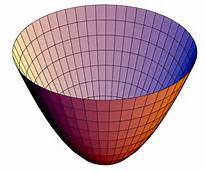The Paraboidal Minima
Find the magnitude of difference in length between the height and diameter of a paraboloid when the quadric surface area including the top is minimized around an enclosed unit volume.

Give your answer to 3 significant figures.
The answer is 0.116.
This section requires Javascript.
You are seeing this because something didn't load right. We suggest you, (a) try
refreshing the page, (b) enabling javascript if it is disabled on your browser and,
finally, (c)
loading the
non-javascript version of this page
. We're sorry about the hassle.
2 solutions
The "r" for the paraboloid with 1 unit volume of water with an open top may not equal the same value as the "r" of the minimum surface area with top found for same 1 unit volume.
It is the same r, both times it is the distance from the edge of the water level to the z-axis.
Knowing that the volume is 1 allows us to express r as a function of a, and using that function, we express the area terms of a alone. Then we find the value of a for which the area is at minimum.
The volume of a paraboloid of equation z = R 2 h r 2 , where h is the height and R is the radius of the top circle, is V = 2 π h R 2 .
The lateral area is more tricky:
A L = ∫ 0 R ∫ 0 2 π 1 + 4 R 4 h 2 r 2 ⋅ r d r d ϕ = 6 π h 2 R [ ( R 2 + 4 h 2 ) 3 / 2 − R 3 ]
The total Area is the sum of A L and the top area A T : A = A L + A T = 6 π h 2 R [ ( R 2 + 4 h 2 ) 3 / 2 − R 3 ] + π R 2
This value is what we need to minimize keeping the volume fixed to V = 1 : we can substitute h = π R 2 2 V = π R 2 2 in the definition of A and take the derivative with respect to R .
The derivative is quite ugly but Mathematica managed to solve the equation d R d A = 0 : that gives R = [ 3 2 ( π 2 3 − π 2 3 ) ] 1 / 6 ≃ 0 . 6 6 3 9 , that implies h = π R 2 2 ≃ 1 . 4 4 4 3 .
The request of the problem is to evaluate the quantity ∣ h − d ∣ = ∣ h − 2 R ∣ = 1 . 4 4 4 3 − 2 ⋅ 0 . 6 6 3 9 = 0 . 1 1 6 5 ,
Exceptional effort using the minimization of the derivative of the area formula for the exact solution.
The scaling of the paraboloid is defined by a: z = f ( r ) = a r 2 .
The enclosed volume is π r 2 a r 2 − ∫ 0 r 2 π x a x 2 d x = π ( a r 4 − a r 4 / 2 ) = 2 π a r 4 . This will be set to 1 later.
The area is a bit more work: The flat 'top' area A f = π r 2 and
the curved area: A q = ∫ 0 r 2 π x d x 2 + d y 2 = 2 π ∫ 0 r x 1 + 4 a 2 x 2 d x .
Substitute t = 1 + 4 a 2 x 2 , then d t 2 = 2 t d t = d 1 + 4 a 2 x 2 = 8 a 2 x d x so that x d x = t d t / 4 a 2 . Now we have
A q = 4 a 2 2 π ∫ 1 1 + 4 a 2 r 2 t 2 d t = 6 a 2 π ( ( 1 + 4 a 2 r 2 ) 2 3 − 1 )
A = A f + A q = π r 2 + 6 a 2 π ( ( 1 + 4 a 2 r 2 ) 2 3 − 1 )
I used the area and volume formulas in the Python code below, which outputted
... a=3.276471, A=5.6750128905 height=1.44425, diameter=1.32785, difference=0.11641